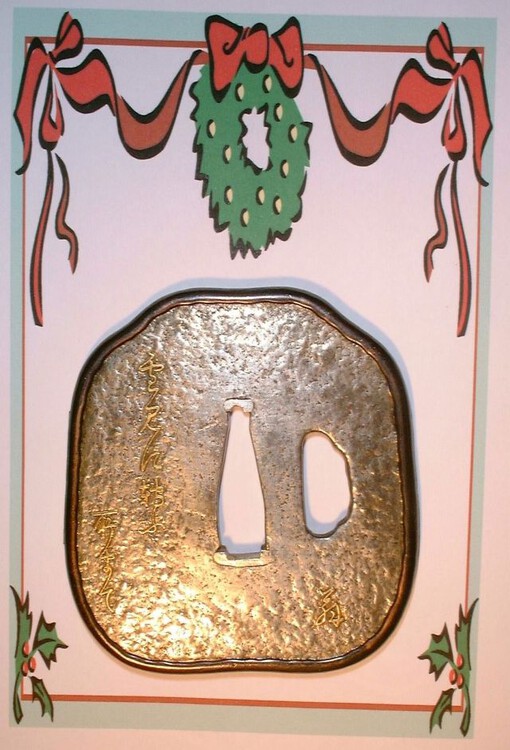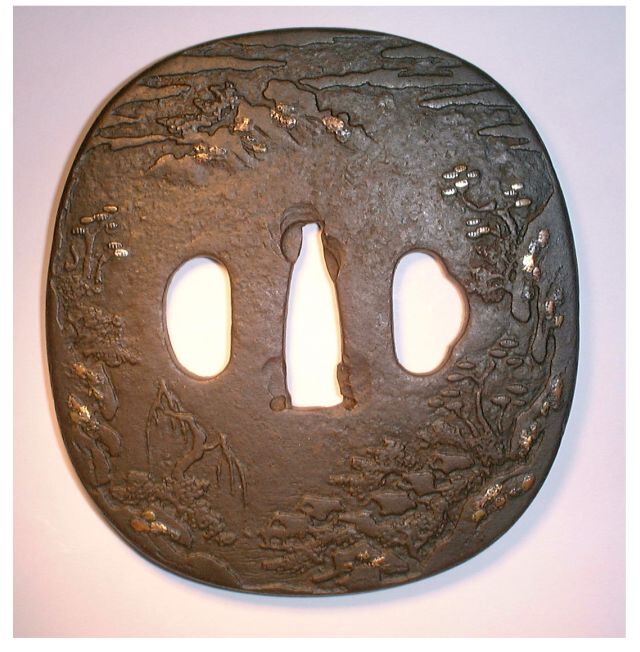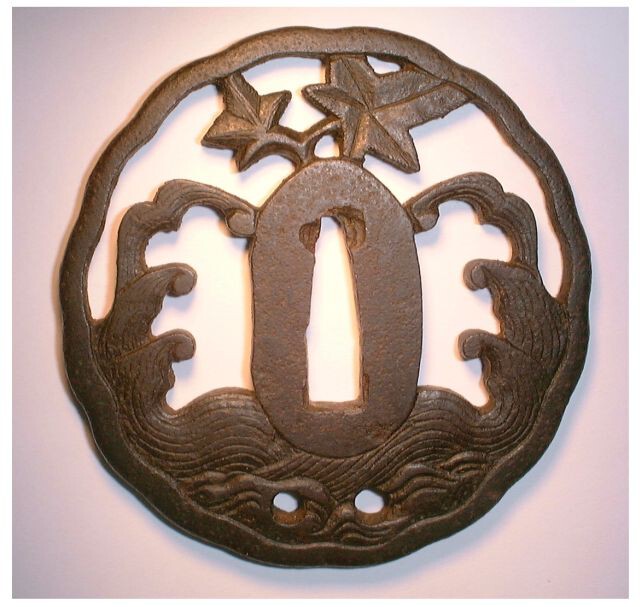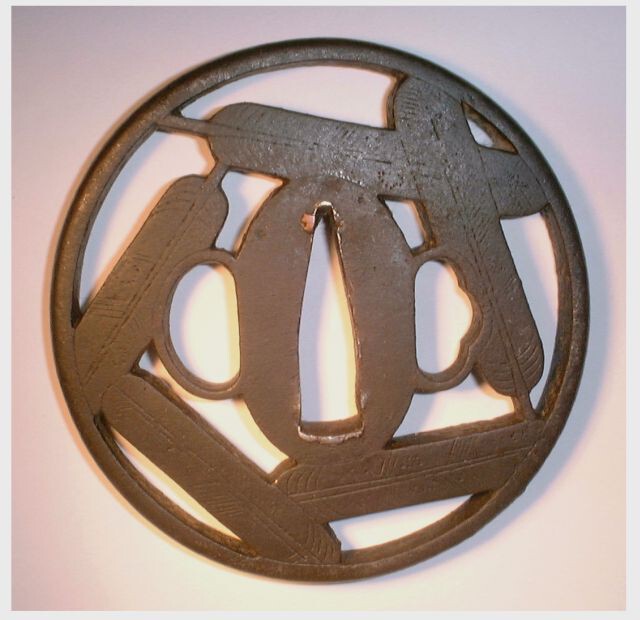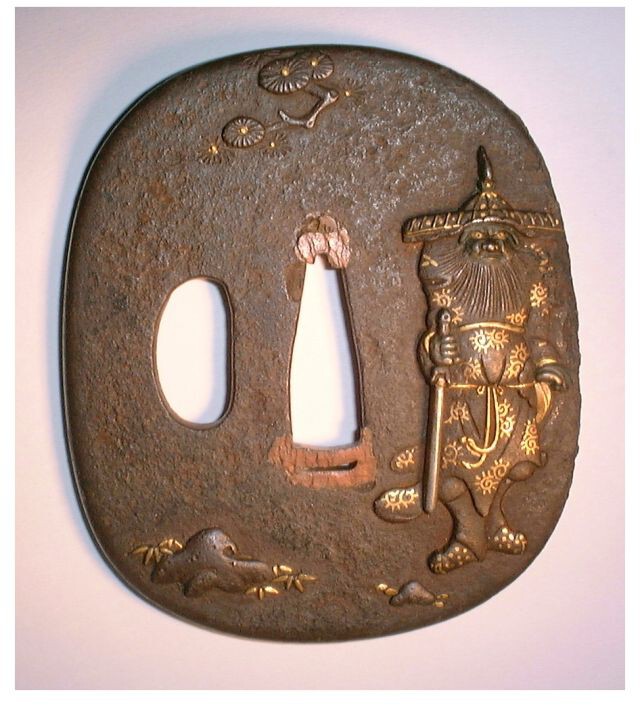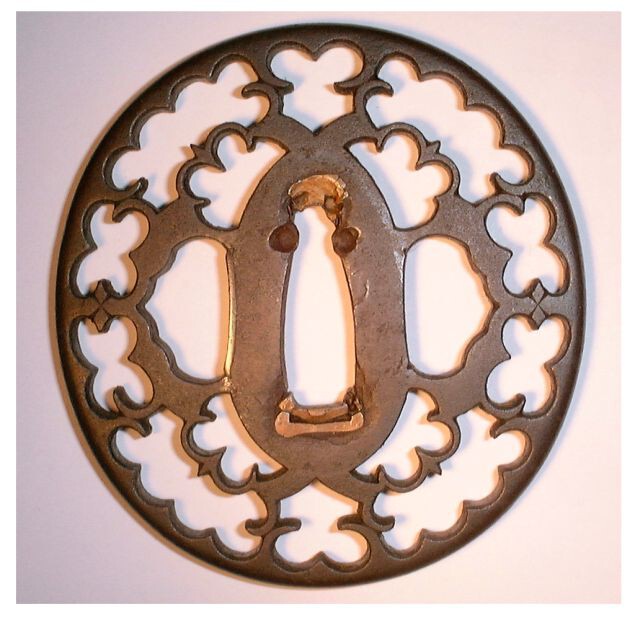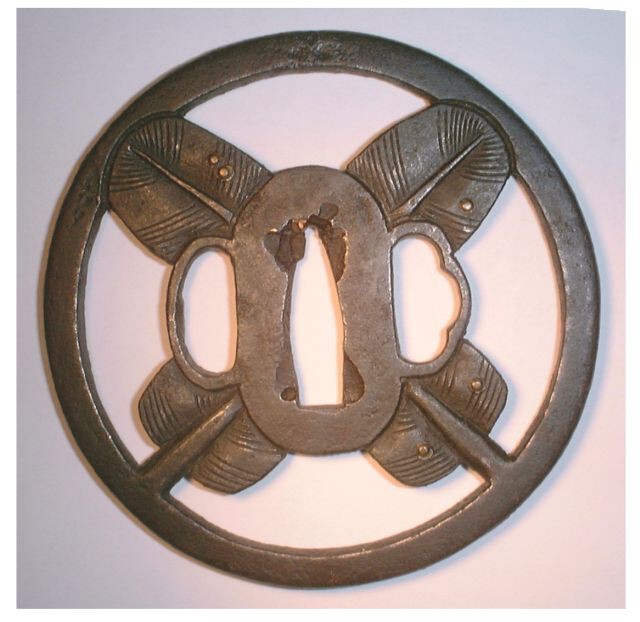-
Posts
815 -
Joined
-
Last visited
-
Days Won
1
Content Type
Profiles
Forums
Events
Store
Downloads
Gallery
Everything posted by docliss
-
John, I sppose that it depends upon what you mean by seppa-dai. A generally accepted definition is 'that part of a tsuba on which the seppa rests', and this does not imply that the area should neccessarily be either raised or clearly defined. If there is a decorative and proud area close to the nakago-hitsu which would preclude the presence of seppa, one might well claim that it is not a 'proper' tsuba, since it was not intended for mounting on a sword. But one sees many tsuba with a low-relief decoration extendings onto this area that also show signs of having been mounted. Several of the presumed Joi tsuba illustrated in WW Winworth's article in The Antique Collector, Vol.39 No.6, demonstrate such a feature. The low-relief and shishiai-bori work of this artist would not have presented any such problems. One of the constants in our interest is that any such dogmatic statement is likely to be subsequently seen as unwise! Regards, John L.
-
With due respects to Ludolf, is not the artist of this kodzuka Ono Yoshitoshi (H 12218.0), ca 1875 - 1900, and working in Edo - Tokyo? Regards, John L.
-
Thanks to Bob for posting the images of the Omi Hakkei tsuba, attributed to the ‘IchijŠGroup’. He suggests that the plaques were described by the vendor as being of pewter, but I feel certain that they are actually of badly tarnished silver. On p. 107 of the publication by Koop and Inada, these Eight Views are listed as: 1. the Autumn Moon at Ishiyama 2. Lingering Snow on Mt. Hira 3. Evening Glow at Seta 4. the Evening Bell at Miidera 5. Returning Sailboats at Yabase 6. Glorious Sunset Sky at Awadzu 7. Night Rain at Karasaki 8. Wild Geese alighting at Katata. It is stated that ‘there is actually no fixed order in this ... series’, but the consistent arrangement of these views on the various tsuba in this thread causes me to question this statement. John.
-
Dear Steve Thank you for posting the new images. It is interesting that the distribution of the eight ‘views’ on the first tsuba is identical to that on my own; also, that corresponding plaques are identical in their profiles. Clearly this is yet another ‘set’ of these Omi Hakkei plaques. John.
-
Dear Piers With appropriate humility I shall make some observations upon your posted tsuba, while realising that more knowledgeable members may well shoot my penn’orth down. In spite of the hammer marks around the nakago-hitsu, this remains fairly ‘virginal’ in appearance. The wide hitsu-ana immediately suggests ShÅami work to me, while the appearance of the iron; the presence of incrustation with soft-metal shells; and the suggestion of a Umetada influence further refine this to Aizu-ShÅami. I therefore suggest that this is C19, Aizu-ShÅami work. Awaiting other comments with interest, John L.
-
Thank you for your comments, Ford. The plaques were, I am, sure, ‘mass produced’ in series of eight. Looking at all three tsuba, it is interesting to note, if you compare their individual plaques, that every example of a specific scene is a constant shape, even if their positioning varies from tsuba to tsuba. It was the appearance of the plate that lead me assume an earlier date. Your suggestion of late Mito work is gratefully acknowledged. Regards, John.
-
Any suggestions as to a possible attribution for this mumei tsuba would be gratefully received. Made in a darkly patinated, granular iron, this tsuba is nade-kaku-gata and measures 8.0 cm – 7.2 cm. It has a squared mimi, 0.6 cm in depth, and is slightly ‘dished’ in profile. On both surfaces are inlayed silver plaques displaying, in low relief, the Omi Hakkei, five on the obverse and three on the reverse. Each of these is surrounded by delicate, gold hira-zÅgan decoration. The nakagÅ-hitsu is well worn, and there are two, conventionally shaped ryÅ-hitsu. Examination of the edge of one of the plaques shows them to be of copper with a silver surface. Two similar tsuba are illustrated in the literature. No 618 in the Dr E Mène’s sale catalogue bears the seal for TÅu and is questionably described a being ‘by one of the Yauchikas’. The other, on p. 93 of Tomihiko’s publication of the Dr W Fahrenhorst collection, demonstrates an identical distribution of the plaques. This is attributed to SatÅ Yoshiteru, but my tsuba is surely earlier than this. With thanks, John L.
-
Could some kind member please explain this correspondence or, alternatively, supply a link to the earlier question? And what is the meaning of 'kinsei'? Many thanks, baffled (John L).
-
Is not the character at the top of this tsuba the bonji (a modified sanskrit character) representing the Boddhisatva Ashuku, one of the five Gods of Wisdom and Contemplation? John L.
-
Dear Michael I believe that I owe you an apology. My wife, who is a bit of an expert on birds - and whose vision is clearly a bit better than mine - tells me that the bird at the back is probably a heron, with the plume. She's not impressed by the 'crow', at the front, and suspects that it may be a duck! Regards, John.
-
Dear Michael The Boston tsuba is described as 'a pair of birds perched on the trunk of (a) willow', and these both appear to be crows. There are, of course, a number of legends associated with crows but I, personally, know of none associated with an egret/crow combination. Regards, John L.
-
Together with my seasonal greetings to all members, I am attaching apposite images of a wakizashi tsuba of jewel-like quality by Tanaka Toshinori (1830 – 1897). Measuring 6.7 cm – 6.1 cm, with a polished, silver ishime surface reminiscent of snow, and a shakudō fukurin, it depicts in high relief a shibuichi straw bag filled with namaguri, some of which have escaped through its meshes. In gold, ‘grass’ characters is inlaid ‘First Snow on the Sumidagawa’, while on the reverse is similarly written the haiku ‘Let us go and see the snow, even if we fall in our haste’, together with the poet’s name. The artist’s gō, Ryūseimin, is engraved upon a shakudō plate on the seppadai. There is a single, asymmetrical hitsu-ana, and silver sekigane in the nakago-hitsu. The river Sumida, which runs through Tokyo, is renowned for the clams found in the mud of its banks. Residents from the area used to visit the Sumidagawa in order to view the first fall of snow and to partake of the delicacy. Ex Behrens and Gilbertson collections. Compare with tsuba no 219 on p. 254 of Ogawa’s Boston catalogue. Ref. Haynes’ Index, H 10531.0, p. 2065. ...... Bauer Collection, # 633, p. 440. Regards, John L.
-
Dear Mikolaj I shall be interested to see if Ludolf agrees with my reply to your query. The inscription on the right of the nakago-hitsu on both of your tsuba appears to be Kozaemon, followed by a kao. Kozaemon was a go used by several of the Jakushi artists, but I am not familiar with the kao. The inscriptions on your tsuba do not correspond to those on p. 162 of Kinko Meikan, but all four of these are different from one another and the identification of work by the various Jakushi artists is extremely difficult. I should certainly consider your daisho pair of tsuba to be good examples of the school's work, but by which of those artists I know not. Regards, John L.
-
Reverting to my preferred kinkō work, I am attaching images of an especially fine ‘Jakushi’ tsuba. This is on an unusually large, thin iron plate, measuring 8.5 cm – 8.0 cm, and is very darkly patinated. The sansui image on both surfaces is devoid of figures, and demonstrates the exquisite, low relief effect that can be obtained by the kusarachi process. Interestingly, the soft metal decoration is confined to a sparse, delicate zōgan of gold and copper, and there are no signs of the profuse nunome-zōgan that devalues much of the later work of this school. The mimi has marked, circumferential grooving, presumably the result of folding during the forging process, and the ryō-hitsu are wide. It is inscribed ura-mei, and this signature is identical to that illustrated on p. 162b of Kinkō Meikan, but unfortunately this entry does not specify to which of the Jakushi artists it refers. The following suggestions have been made as to its attribution: • Based upon the presence of the ura-mei, it is a ‘made to order’ tsuba by the nidai, who reverted to the style of his father while making it. • It is by Jakushi Koretaka who, working in the mid-1800s, produced work that Hayes states are ‘almost equal to that of the first master’. • Because of the wide ryō-hitsu and the oblong form of the gold and copper nunome on the trees, it is a very good (?Aizu) Shōami copy of Jakushi work. I look forward to reading your opinions. Regards, John L.
-
Interestingly, a very similar design appears on p. 193 of Watson's translation of Nihon To Koza, Vol. VI Part 1, and is attributed simply to 'Akasaka'. This may be even earlier than the mid-C19 of Goto Ichijo or the earlier C19 of Otsuki Mitsuhiro. Regards, John L.
-
Hoping to have some more queries answered, I am attaching three final images of iron tsuba for members’ consideration. Tsuba J This is an openwork guard, measuring 8.8 cm – 7.8 cm, in a granular and darkly patinated metal. Within a solid, undulating mimi, the theme is that of tatsunami and momiji in a low relief, positive silhouette. There are two udenuki-ana, a single hitsu-ana, and the well-worn nakago-hitsu contains copper sekigane. I presume this tsuba to fall under the heading of ‘Yagyu’, but am not sure when such a tsuba ceases to be properly classified by this name. Does the design have to have appeared in the Yagyu pattern book? And what about later copies by, for example, Iwata Norisuke? Tsuba K Depicting five takaha in positive silhouette within a solid, rounded border, this maru-gata tsuba measures 7.6 cm – 7.6 cm and is very darkly patinated. It is almost 6 mm at the seppa-dai, decreasing slightly in its thickness toward the mimi. The kebori detail on the takaha is so worn as to be barely visible in places, and there are granular tekkotsu visible on the mimi. The two ryo-hitsu are within solid rims, that for the kogai being rather small, and there is copper sekigane in the nakago-hitsu. I presume this to be Akasaka work, but does its small kogai-hitsu and – as suggested by a member in a previous posting – its greater thickness, both suggest an earlier date? Tsuba L To close, I have attached this image of a beautiful, early Nara guard as a ‘bonne bouche’ for those ‘kinko men’ who have been patiently reading about iron guards as a result of my previous three submissions. It is aori-gata, measuring 7.0 cm – 6.0 cm, and depicts, in a high relief iroye of iron, silver and gold, Shoki with his kebori beard, great hat and silver ken. On the reverse, hiding from him up a tree, is a copper oni. Regards, John L.
-
Yes, please, I would very much like to have it. With thanks, J.
-
Dear Scott If you are suggesting that the quality of the nanako on ko-kinko work was generally lower than that found on better, later Edo work, you may well be correct. But you only have to look closely at early, high quality Goto work to see the effect that prolonged wear has on the more exposed surfaces. Regards, John L.
-
John, very many thanks for that - I shall certainly try one of those formulae. Regards, John L.
-
So, can anyone out there tell me how to repatinate my two shakudo umagane - apart, that is, from spitting on them? John L.
-
Brian Repatination by a previous owner is always a possibility, I agree, and is very difficult to confirm. 'Natural' repatination I am not too sure about - I have in my collection a beautiful iron tsuba, its ryo-hitsu filled with raw, copper-like umagane, and these have not changed their colour one iota over the past 20 years! Regards, John L.
-
Further to my last message, I have been seeking an explanation as to why long-term wear on soft metal fittings, to such an extent that the nanako is almost flattened, does not result in a loss of the patination. If this degree of flattening were the result of abrasion, the patination - of only a few microns thickness - would certainly be lost. Is it therefore possible that the long-term handling of the fittings produces a degree of flow in the surface metal, thus causing a change in its profile without affecting the overlying patina? Additionally, since the nanako is produced by hammering - which results in tensions within the metal - the natural elasticity of the metal will tend to reduce these and to slowly restore the metal to a plane surface. I suggest that the nanako of a soft metal fitting would thus gradually reduce in magnitude if it were simply stored for a few hundred years without being subjected to any wear. Regards, John L.
-
Thank you for that - I am surprised by it, and am completely at a loss to understand it when even excessive rubbing with a cloth can sometimes remove the patina and expose the raw, copper metal of shakudo. John L.
-
I, too, would confidently label this tsuba as Momoyama Ko-Kinko work, but the exaggerated wear does pose some questions. Surely that measure of wear would have exposed the raw metal, and either the tsuba has been repatinated at some stage in its long life or - and more probably - the artist deliberately created the impression of increased ageing by 'going easy' on the decoration. Regards, John L.
-
I am attaching images of three more iron tsuba, in a search for some information as to their attribution. I hope that Brian will tell me if he believes me to be monopolising the message board with my enquiries. Tsuba G This is an openwork guard, rendered in a dark, granular iron. It measures 7.0 cm – 6.5 cm, and has a rounded, chrysanthemoid rim. The design incorporates bracken shoots, flying geese, ginger roots and a ni-hichi mon. The ryo-hitsu are ogival and only one retains its shakudo sekigane. The seppa-dai is rather pointed in outline, and contains several generations of copper sekigane. Am I correct in thinking this to be Akasaka work? Tsuba H A heavy, openwork guard in a darkly patinated iron, this has a thick, square mimi enclosing two, crossed takaha. These are depicted in a low relief engraving with kebori detail, and have a rich brown, brass ten-zogan decoration. There are two ryo-hitsu within thick, solid rims, and the rather rectagonal nakago-hitsu — is this what Torigoye means by ‘koban shape’ — is well worn. ? Ko-Shoami work, but the brass ten-zogan has me puzzled. Tsuba I Nade-kaku-gata, and measuring 6.9 cm – 6.5 cm, this openwork tsuba has a darkly patinated and slightly polished surface. Within the rounded rim are depicted, in positive silhouette, two double-diamond mon linked to four bracken shoots. The ryo-hitsu are of a conventional size and shape, and the nakago-hitsu has lead sekigane. Is this another Akasaka guard? With thanks, John L.






